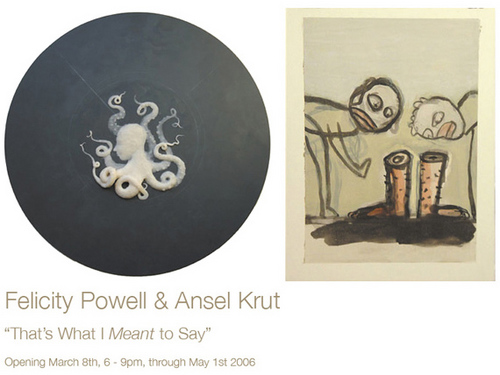Ansel Krut and Felicity Powell
dal 7/3/2006 al 30/4/2006
Segnalato da
7/3/2006
Ansel Krut and Felicity Powell
David Krut Projects, New York
That's What I Meant to Say

That's What I Meant to Say
A giant fly, a six-footer, has been interrupted in an act of auto-digestion. His reproachful gaze is at once an admonition and an accusation. A little girl gazes at her bloodied finger, her eye has swollen to accommodate the enormity of what she sees. There is a trace of blood on her lips. Two figures have stumbled on a pair of severed legs in a field. They show tender solicitude for the abandoned limbs. There is more: a boy pissing into an electric socket, an exploding torso, warring insects, humanoid vegetables and regressed humans, double headed figures and small birds balancing on eyeballs.
Krut is exhibiting a large painting (Huge Self Digesting Fly) and a body of ink drawings, some with watercolor. All his work is characterized by an absurdist view of life, a world emancipated in particular of moral purpose. His grotesque and provocative inventions, drawing on paradoxes, vaudeville and the raree show, are on the razors between nonsense and moral criticism. The work is suffused with the spirits of Gilray, Goya and Guston. The imagery is direct, vulgar and insistent, calling to mind popular graphics, animation, low life broadsheets and outsider art.
Fifteen heads, all but one in profile, have been sculpted in low relief using white wax on a dark glass ground. They exist as original objects but also form the basis for a video animation in which the heads slyly reconfigure themselves. Full of subtle and macabre humor, the use of stop-frame animation and black and white gives the video the feel of early animation. The heads are always in the process of change, each is infused with metamorphic potential: growing antlers, extruding tentacles, becoming coral. The images have the wonder and strangeness of exhibits from a cabinet of curiosities.
The wax on glass is at once bony and fleshy, dense and translucent, solid and fluid. Powell articulates the subtleties of the wax against the dark ground in an arcane act of reverse drawing, light onto dark. Like cinema, but with light embodied. Light wax against a dark ground is a technique that was used by seventeenth Century medal makers such as the Hamerani family in Rome. In Powell’s work the dark ground becomes a metaphysical space, the site of possibilities.
Like their historical prototypes, these works are made with finesse and attention to delicate detail that refers back to a skills-based tradition, but which in Powell’s hands is alive to contemporary sensibility.
Ansel Krut is a painter who lives and works in London. He received his MA (Painting) from the Royal College of Art, London and was awarded the Abbey Major scholarship to Rome. His work is in the collections of the Arts Council England, the British Council, the Government Art Collection UK, the Johannesburg Art Gallery and The Wellcome Foundation among others. Krut has exhibited extensively internationally, is a lecturer in the Painting Department at the Royal College of Art and is currently the Fellow in Drawing at Wimbledon School of Art.
Felicity Powell is a London-based artist with an MA in Sculpture from the Royal Academy, London. She was awarded the Gulbenkian Rome Scholarship, and the British Museum departments of Prints and Drawings and Coins and Medals have collected her work. Her site-specific installation Drawn from the Well, was exhibited from 2002- 2004 at the V&A Museum London in the main sculpture courts. Her video work has been shown at Domo Baal Gallery London and is touring Thailand with the British Council. She is a lecturer in Fine Art at University College Falmouth and City and Guilds London.
Ansel Krut’s work is exhibited courtesy of DOMOBAAL London
Opening reception, Wednesday March 8th, 6 - 9pm
David Krut Projects
526 West 26th Street #816 NYC 10001



